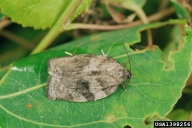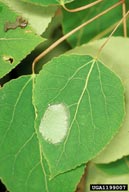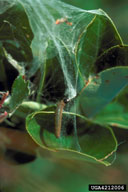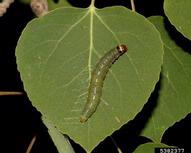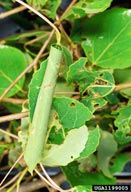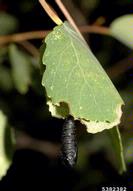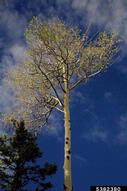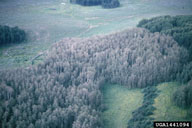Large aspen tortrix
Choristoneura conflictana (Walker) (Lepidoptera: Tortricidae)
Orientation to pest
Large aspen tortrix, Choristoneura conflictana (Walker), is a native North American tortricid moth found throughout the range of quaking aspen (Populus tremuloides Michx.) in Canada and the United States. In Canada, adults lay their eggs in June or July in flat clusters, usually on the leaves. Eggs hatch and the first instars feed together on leaves, webbing foliage together. Fed first instars then move to the trunk where they create hibernaculae and overwinter as second instars. In the spring of the following year, larvae emerge and feed by mining the swelling buds. Later, larvae feed in leaf rolls. Pupation occurs in the leaf rolls, and adults emerge in a few weeks to lay eggs of the new generation. Defoliating outbreaks have occurred in the aspen stands in Canada, Alaska, New England, New York, and Michigan. Reasons for outbreaks have not been studied, but the existence of overwintering young larvae that feed on buds the following year suggests that variation in the degree of synchrony (driven by annual weather events) between bud break and larvae resumption of feeding is likely to be a factor.
Hosts commonly attacked
The large aspen tortrix is mainly associated with quaking aspen (P. tremuloides) but also feeds on balsam poplar (Populus sect. tacamahaca), bigtooth aspen (Populus grandidentata Michaux), paper birch (Betula papyrifera Marsh.), willow (Salix), and alder (Alnus).
Distribution
This moth is found throughout the range of quaking aspen in Canada and the United States.
Images of large aspen tortrix
| Figure 2. Adult of the western spruce budworm, Choristoneura occidentalis | Figure 3. Egg mass of large aspen tortrix | Figure 4. Young larvae of large aspen tortrix, feeding on webbed leaves | Figure 4. Mature larva of large aspen tortrix |
| Figure 5. Rolled leaf, feeding site of older larvae of large aspen tortrix | Figure 6. Pupa of large aspen tortrix | Figure 7. Quaking aspen defoliated by large aspen tortrix | Figure 8. Aerial view of area defoliated by large aspen tortrix |
Important biological control agents related to this pest species
A large number of species of parasitoids (>20) have been reared from larvae and pupae in several locations where studies have been conducted (Alberta, Canada; Alaska). Collectively, these cause significant levels of mortality, up to 50% in some cases. Among the more important species are Macrocentrus iridescens French, Glypta inversa Cresson, Glypta fumiferanae (Viereck), and Agathis annulipes (Cresson).
Web links for information on large aspen tortrix
- Fact Sheet | Natural Resources Canada
- Fact Sheet | University of Alaska Fairbanks and USDA
- Forest Insect & Disease Leaflet 139 | USDA Forest Service
- Fact Sheet | E.H. Strickland Entomological Museum, University of Alberta
Articles
- Torgersen, T. R. and R. C. Beckwith. 1974. Parasitoids associated with the large aspen tortrix, Choristoneura conflictana (Lepidoptera: Tortricidae), in interior Alaska. The Canadian Entomologist 106: 1247-1265.
- Jones, B. C., J. Roland, and M. L. Evenden. 2009. Development of a combined sex pheromone-based monitoring system for Malacosoma disstria (Lepidoptera: Lasoicampidae) and Choristoneura conflictana (Lepidoptera: Tortricidae). Environmental Entomology 38: 459-471.
